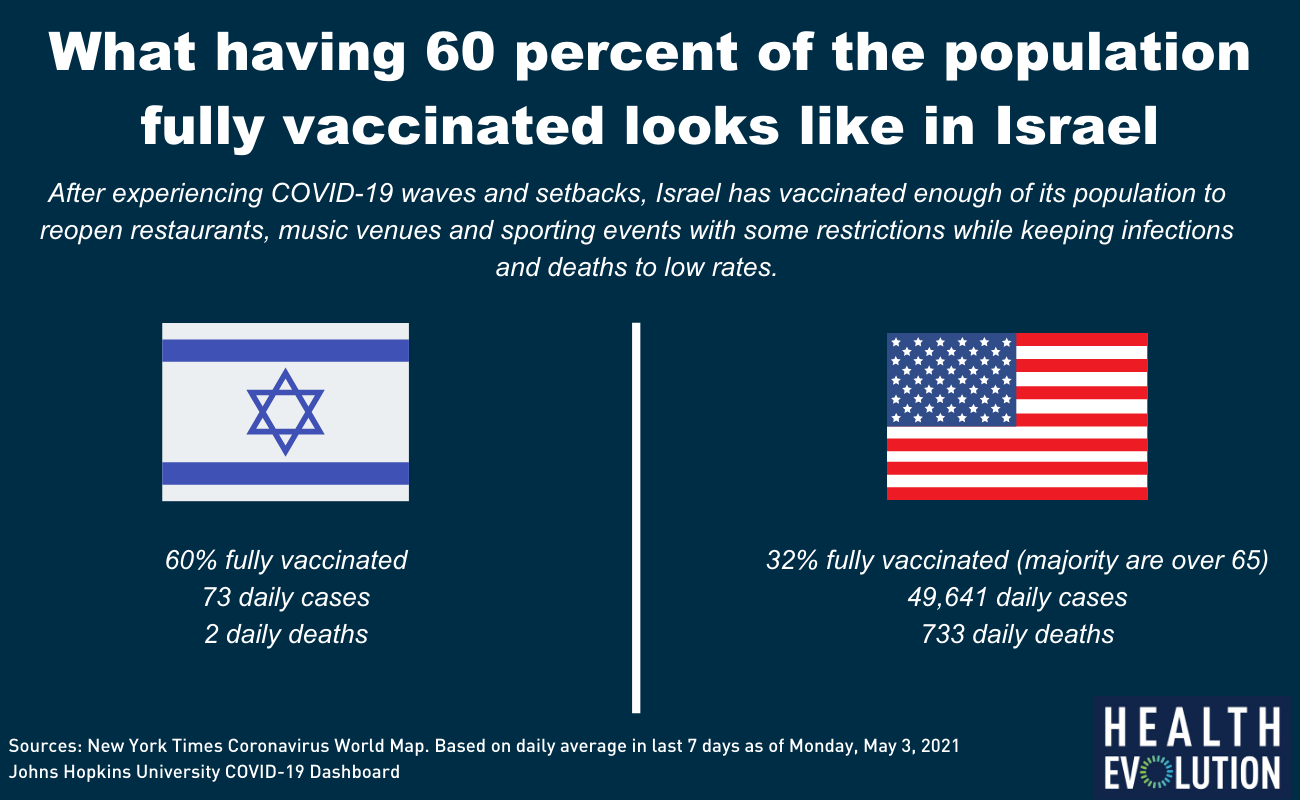Herd immunity has been an elusive goal since the pandemic’s beginning. Public health officials differed about what percentage of the population must be vaccinated or have the antibodies to achieve herd immunity with projections ranging from 60-70 percent all the way up to 90 percent. This week, another wrinkle: Experts are saying that the U.S. will never reach herd immunity, while others are holding up Israel as an example of how effective a 60 percent inoculation rate can be and President Joe Biden set a new goal of administering at least one shot to 70 percent of Americans by July 4, 2021.
The pressing matters, then, are whether the government’s goal is achievable given that vaccine distribution is slowing down and determining if vaccinating 70 percent of Americans or a close percentage will make it safe to reopen the economy.
Israel, for instance, has fully vaccinated more than 60 percent of its population, partially reopened restaurants, live music venues, sporting events, all the while managing to reduce daily deaths down to single digit numbers. “The Israel data should make us feel optimistic and persuade people to get the shots,” Harvard epidemiologist William Hanage said in a Vox article. Natalie Dean, a biostatistician at the University of Florida, added that the results “bode well for what we can do in the U.S. Maybe we can get really far off of 60 percent of people being vaccinated.”
Certainly when measured by vaccination rates, Israel is well ahead of the U.S., where 32 percent of the population is fully vaccinated and 45 percent has received one dose, as of May 4, 2021 statistics. But the majority of those people are 65 and older, while the largest group of hospitalized Americans are adults younger than 50, according to the U.S. Centers for Disease Control and Prevention’s COVID Data Tracker.
Increasing vaccine uptake in diverse communities: A guide for CEOs
While there are reasons to be optimistic, there is no guarantee that a 60 percent inoculation rate will work as well in the U.S. as it has in Israel and the U.S. has considerable ground to cover before that much of the population is fully vaccinated. As of May 4, 2021, U.S. cases are down 26 percent to 40,531 compared to 14 days ago and new deaths declined 2 percent to 890.
At the same time, however, CDC data illustrates that vaccine distribution has been slowing down. The agency tracks the average number of first or single doses administered daily and since April 13 that has dropped nearly 50 percent — in part but not entirely because of the J&J vaccine being paused due to rare instances of blood clots. What’s more, as of late last week approximately 8 percent of Americans who had already received the first dose did not return for a second shot, CDC noted, which will not make getting to 60 percent any more efficient.
Whether 70 or 60 percent will in fact be enough to safely re-open the U.S. economy remains to be seen — as does the exact percentage of fully vaccinated Americans required to achieve herd immunity. But the realization that the U.S. and other countries may never achieve true herd immunity is not new. Former FDA Director Scott Gottlieb, MD, said on CNBC in April that vaccinations are reducing the public’s vulnerability to COIVD-19. “I don’t think we should be thinking about achieving herd immunity,” Gottlieb said. “I think it’s always going to circulate at a low level. That should be the goal, to keep the level of virus down.”
Likewise, Anthony Fauci, MD, Director, National Institute of Allergies and Infectious Disease, agreed this week that it’s time to move away from the concept of herd immunity because it is difficult to define, according to The Washington Post. “We’ve made estimates that [herd immunity] is somewhere between 70 and 85 percent, but we don’t know that as a fact,” Fauci said. “So rather than concentrating on an elusive number, let’s get as many people vaccinated as quickly as we possibly can.”
Homepage image credit: Steven Cornfield/Unsplash
Related articles:
The politicization of vaccines and public health illustrates the depth of inequities
Public health messaging 101: How to convince the vaccine skeptics
Ad Council exec on COVID-19 vaccine campaign: ‘We are wired for crisis’
With public trust in COVID vaccines fading, health CEOs must be trust amplifiers
CEOs look to keep transforming health care in 2021











